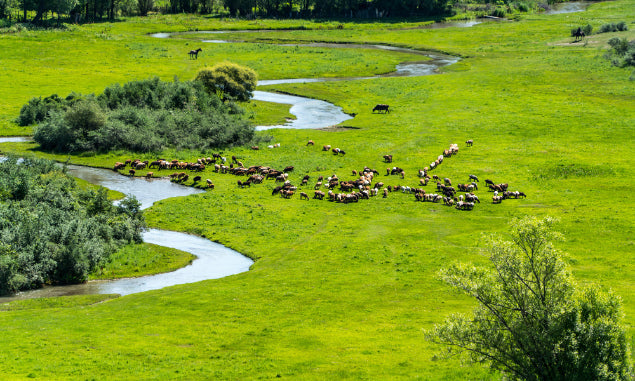Takhi at Dusk: Waiting for Mongolia’s Wild Horses
Late light pours across the steppe like warm copper. A west wind combs the grass into ripples, and the ridge you’ve been watching all afternoon finally exhales a shape: square muzzle, heavy neck, a dun coat with a dark eel-stripe along the spine. Then another. Then five more. Takhi—Mongolia’s wild horses—move as if they remember the world before roads. Your breath decides to be very quiet.
This is not a chase story. It’s a waiting story. And waiting, it turns out, is the secret to seeing Mongolia at its best.
If that sounds like your kind of evening, the Steppe to Sand journey folds Khustai’s horse country into a 14-day arc of valleys, dunes, and flaming cliffs—logistics handled, patience rewarded.

Where the Horses Keep Time
Takhi are creatures of distance and breeze lines. In Khustai, you glass the slopes, follow your guide’s eyes, and let the day narrow to the colour of grass and the direction of ears. Dusk is when the steppe softens and movement gathers; it’s also when your capacity to stand still gets tested. Good. Stillness is your ticket.
The Art of the Long Look
Bring binoculars and the willingness to let them hang for long minutes while you simply watch. Scan for the ridge-line punctuation—brown commas against the sky—then drop your gaze to the middleground, where tails flick and the foals stay close in the lee of the herd. You’ll see more by not trying to see everything. Horses read pressure; so does the land.
-
Pick a line and hold it. If the group inches forward, you don’t have to. The best moments often walk to those who wait.
-
Talk in whispers, walk on grass. The steppe carries sound farther than you think.
-
Let your guide choreograph. Wind, sightlines, and exit routes matter; they’re thinking three moves ahead so the horses never have to.
What Counts as “Success” Out Here
A perfect evening isn’t a close-up; it’s a story arc. Early: silhouettes and distance. Middle: a slow swing across a slope, foals testing their legs. Late: the herd settles, the stallion posts himself like punctuation at the edge. If your photos still include the horizon, you’ve done it right. If your shoulders have dropped an inch and you can hear the grass, you’ve done it better.
Etiquette That Keeps the Wild in “Wild Horses”
-
Hold generous space. Distance is respect—and the reason the behaviour you witness stays real.
-
No calling, no clapping, no salt-lick bravado. You’re not summoning a pony; you’re passing through a home.
-
Follow tracks, not temptation. Keep to agreed lines to protect fragile ground and grazing patterns.
-
Pack your patience. If the ridge stays empty, you earned a quiet evening on the steppe. That’s not “nothing”; that’s Mongolia doing Mongolia.
Gear for a Dusk That Runs Long
-
Layers that stack: the temperature drops fast when the light does.
-
A compact sit-pad: rocks are honest; comfort helps you wait well.
-
Binoculars & a simple lens: 8× or 10× glass; 200–300mm is plenty if you keep the habitat in frame.
-
Headlamp with red mode: for the walk back without stadium lighting.
-
Thermos: tea tastes better when the horses appear on the last sip.
The Moment After the Moment
When the herd ghosts into the dark, don’t rush the pack-up. Let your eyes downshift to night vision. Listen: larks finishing, crickets starting, a fox making punctuation marks in the grass. The drive back feels different when you leave a little silence behind you.
Back at the ger, the stove wakes with a friendly clatter. Someone pours tea that tastes faintly of woodsmoke. You’ll talk about what you saw, then you’ll talk about something else entirely. That’s how you know the evening worked: it gave you more than horses.
If you’d like those evenings bundled into a wider loop—Orkhon’s valley life, Gobi canyons, dune lines at sunset—the 14-day Mongolia route is already tuned for dawns and dusks, not crowds and clocks.
Why a Guided Evening Changes Everything
You can gamble on guesses, or you can borrow a lifetime of patterns. A good guide reads the day like a weathered book: which ridge cools first, where the wind scuffs least, how far to stand so the stallion never flicks an ear your way. They also know when to say “enough” and steer you home with that warm, earned-tired feeling. You bring presence; they bring fluency. Together, you get a cleaner storyline.

When the Steppe Decides Otherwise
Sometimes the horses don’t show. The land offers ravens instead, or a distant herd too far for detail. Accept the gift as given. Wander a little closer to the sky. Photograph the wind’s handwriting in the grass. You came for wildness; this, too, is wild.
Threading the Horses Into the Journey
Khustai is one chapter. The book reads better when you turn the page: river-carved days in the Orkhon, the cool throat of Yolyn Am canyon, sunset at the Flaming Cliffs where reds stretch into improbable names for colour. Stitch it cleanly and you get a story that deepens as it runs. That stitching is the whole point of the Mongolian Legends loop—pace, places, and patient evenings already built in.
If the ridge is calling…
Pack the layers, choose stillness, and trust the long look. Out here, the world arrives on its own timing—and if you let it, dusk will hand you a wild horse and a quieter version of yourself.




